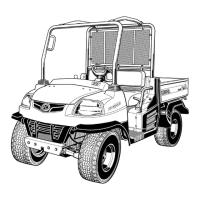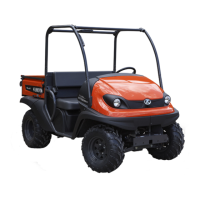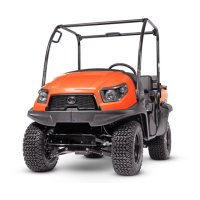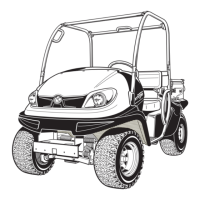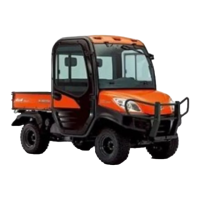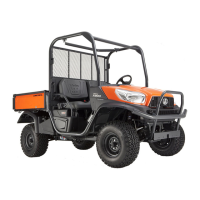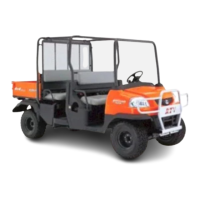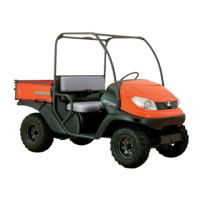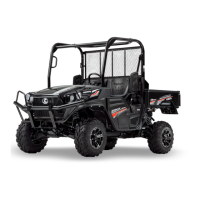• Pulling
the auxiliary-port-lever (B) sends oil to the
pipe-B (F).
• Pressing the auxiliary-port-lever-lock-knob fully to
the lock position (C), you can hold the position of
auxiliary-port-lever.
(1) Auxiliary port lever
(2)
Auxiliary port lever lock knob
(3) Pipe-1
(4) Pipe-2
(A) Push
(B) Pull
(C) Lock
(D) Unlock
(E) Oil to pipe-1
(F) Oil to pipe-2
Max. flow volume (theoretical) 42.1 L/min.
Max. pressure
18.6 MPa
(190 kgf/cm
2
)
IMPORTANT :
• When
you do not use the auxiliary port for a
long period, dirt particles can settle in the lower
part of the auxiliary-port-lines.
When you remove the plugs on the auxiliary-
port-lines to connect attachments, drain the
following amount of oil per side before
connecting.
Oil Approx. 0.1 L
RELEASING THE PRESSURE
TRAPPED IN THE HYDRAULIC
SYSTEM
1. Lower the attachments to the ground and push the
control-lever-lock-knob and auxiliary-port-lever-lock-
knob to lock.
2. Turn the starter key to the [STOP] position and shut
off the engine.
3. Pull the control-lever-lock-knob and auxiliary-port-
lever-lock-knob to unlock.
(1) Control lever lock knob
(2) Auxiliary port lever lock knob
(A) Lock
(B) Unlock
4. Move
the control lever to release the pressure in
the hydraulic system.
MULTI-COUPLER TO ATTACH
THE FRONT A
TTACHMENT
1. Mechanical multi-coupler
This machine utilizes a mechanical multi-coupler for
easy
connection and disconnection of various
attachments.
By replacing the front attachments, you can use this
machine in agriculture, raising stock, landscaping,
gardening, and snow removal as well as general civil
engineering and construction work.
1.1 Attaching the front attachments to the
mechanical multi-coupler
Attach the front attachments to the mechanical multi-
coupler as the procedure in this section.
WARNING
T
o avoid personal injury or death:
• After carrying out the attaching procedures of
front attachments, make sure that the front
attachment is securely attached to the
mechanical multi-coupler, or the front
attachment may be detached.
RELEASING THE PRESSURE TRAPPED IN THE HYDRAULIC SYSTEM
OPERATION OF THE MACHINE



